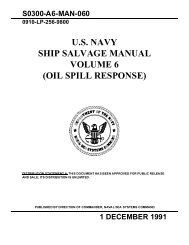U.S. NAVY SALVAGE REPORT DEEPWATER HORIZON ... - ESSM
U.S. NAVY SALVAGE REPORT DEEPWATER HORIZON ... - ESSM
U.S. NAVY SALVAGE REPORT DEEPWATER HORIZON ... - ESSM
Create successful ePaper yourself
Turn your PDF publications into a flip-book with our unique Google optimized e-Paper software.
Deepwater Horizon Oil Spill Response<br />
Richard Buckingham, and finally to the Command Center in Gulfport became a high priority, stop<br />
everything drill requiring immediate, high level attention.<br />
After staffing ad hoc responses to numerous “good ideas” coming from both the public and<br />
private sector, the National Incident Commander established an Interagency Alternative<br />
Technology Assessment Panel (IATAP) to provide an established process to fairly evaluate the<br />
merits of plausible improvements to the oil cleanup process. The establishment of this<br />
assessment program took a significant load off the Navy staff, reducing the number of<br />
distractions and demands on their time for issues relating to suggested process improvements.<br />
Examples of the IATAP evaluations SUPSALV personnel took part in are included in Para 5-3.3.<br />
2-2.7 Access to Fresh Oil<br />
Crude oil bubbling to the surface has a different consistency than oil that has been floating for a<br />
couple of days. The aged oil turns into a thick, slimy mess and becomes contaminated with<br />
floating ocean debris. Clean fresh oil is more easily handled and can be separated from the<br />
water efficiently by SUPSALV’s skimmer systems. For these reasons, the SUPSALV VOSS<br />
teams always desired assignment to the Gulf waters in the vicinity of the flowing oil. Conflicting<br />
priorities at the well site didn’t always allow that access. Because multiple strategies were being<br />
employed; In-situ burn, mechanical recovery (large volume skimmers), and dispersal,<br />
SUPSALV’s VOSS teams were not always given access to the fresh oil. The decision makers<br />
were balancing multiple priorities but from SUPSALV’s perspective, their VOSS OSVs which<br />
were manned and ready to collect oil were not always placed where the fresh oil was.<br />
2-2.8 Timely Aerial Reconnaissance.<br />
Offshore Support Vessels (OSV) with NOFI VOSS skimmers deployed are limited to traveling at<br />
about 3 knots. Other VOSS skimmers are slower, at about 0.8 kts. MARCO Class V skimmers<br />
move at 1.0 kts unless rigged for towing where they are capable of 5 – 6 kts. Retrieving gear<br />
and redeploying it is time consuming. Because of this slow pace of advance, sending VOSS or<br />
MARCO belt skimmers off in search of oil spotted the day before was ineffective and wasteful.<br />
The delay between sighting oil and getting assigned to a patrol / skimming area meant that the<br />
skimmers were often looking for the spotted pockets of oil from the height of eye of the wheel<br />
house rather than having a timely aerial reconnaissance locate the oil.<br />
In an attempt to improve timeliness of oil spotting reports, the Navy activated its airship, MZ-3A<br />
which arrived in the Gulf Region on 6 July to assist in spotting and monitoring oil and support<br />
command and control of skimming operations. The Airship began operating from a mooring three<br />
miles Southeast of Mobile Bay but was later based at Jack Edwards Airport AL, just east of<br />
Mobile Bay. It typically flew six-hour sorties and would report surface oil sightings to the task<br />
force. Communications with the afloat task force and ICP leadership proved difficult and the<br />
airship did not make the contribution that was hoped for.<br />
2-7

















